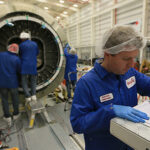
One of the most awaited astronomical observatories of our time is the James Webb Space Telescope (JWST). Named after the former NASA Administrator James E. Webb, this space-based telescope is a collaborative project between NASA, the Canadian Space Agency (CSA), and the European Space Agency (ESA). The JWST is ready to transform how we perceive the cosmos thanks to its ground-breaking features.
In this blog, we will delve into the various features and capabilities of the James Webb Telescope, highlighting its significance and potential impact on space exploration and astronomy.
The Hubble Space Telescope will be replaced by the James Webb Telescope, which is the next-generation space observatory. It aims to reveal the answer to unanswered questions about the cosmos.
It will go more deeply into our past and potential future. The formation of planets and stars, as well as the emergence of the first galaxies in the early Universe, will be depicted in a clear and coherent manner. In every area of astronomy and astrophysics, Webb will produce astounding findings.
What Is James Webb Telescope?
The James Webb Telescope is a spacecraft telescope built to find the Universe’s coldest and most distant objects. Additionally, it will analyze other cosmic occurrences and distant, potentially habitable worlds. JWST’s primary objective is to outperform the Hubble Telescope in terms of reach.
It bears the name of James E. Webb, a NASA administrator who oversaw the Mercury, Gemini, and Apollo missions between 1961 and 1968.
Together with the Canadian Space Agency and the European Space Agency, NASA oversaw the development of JWST. The launch day for the telescope was December 25, 2021. From Kourou, French Guiana, an Ariane 5 rocket placed the telescope into orbit.
Compared to the Hubble Telescope, it will offer superior infrared sensitivity and high resolution for james webb telescope images. Compared to all other significant telescopes on and off the Earth, the viewing power is over 100 times larger. Similar kinds of information is present in this site of Youth ki Awaz.
Features Of James Web Telescope
1. Mass
The James Webb Space Telescope’s mass is approximately half that of the Hubble Space Telescope.
2. Primary Mirror
Webb has a 6.5 m (21 ft) diameter gold-coated beryllium primary mirror consisting of 18 separate hexagonal mirrors.
3. Collecting Area
Webb’s mirror provides a total collecting area of 25.4 m2 (273 sq ft). Over six times larger than Hubble’s 2.4 m (7.9 ft) diameter mirror with a collecting area of 4.0 m2 (43 sq ft).
4. Near-Infrared Astronomy
Webb is primarily designed for near-infrared astronomy, with the ability to see orange and red visible light. As well as the mid-infrared region depending on the instrument in use.
5. Sensitivity
Webb can detect objects up to 100 times fainter than Hubble and observe objects from the early universe, back to redshift z≈20 (about 180 million years cosmic time after the Big Bang).
6. Early Universe Observation
The telescope’s capabilities allow it to observe objects from the time of the earliest stars and galaxies, which formed around redshift z≈30 to z≈15 (100–270 million years cosmic time).
7. Infrared Emphasis
Webb’s design prioritizes near-to-mid-infrared observations for several reasons. Including the shift of high-redshift objects’ emissions into the infrared, and easy passage through dust clouds. And also strong emissions from colder objects in the infrared.
8. Challenging Observations
Infrared bands are challenging to study from the ground or existing space telescopes like Hubble, making Webb’s capabilities invaluable for advanced research.
9. Atmospheric Opacity
Ground-based telescopes must contend with Earth’s atmosphere, which is opaque in many infrared bands, hindering observations in those regions.
10. Complicated Analysis
Even in transparent regions, Earth’s atmosphere contains target chemical compounds, such as water, carbon dioxide, and methane, making analysis complex.
11. Radiative Interference
Existing space telescopes like Hubble cannot study certain bands due to insufficiently cool mirrors, causing strong radiation interference in the relevant infrared bands.
12. Infrared Advantage
The James Webb Telescope is designed for infrared astronomy, allowing it to observe objects that emit infrared bands.
13. Solar System Observation
JWST can observe objects in the Solar System, including Mars, Jupiter, Saturn, Uranus, Neptune, Pluto, their satellites, comets, asteroids, and minor planets beyond the orbit of Mars.
14. Kuiper Belt Objects
With near-IR and mid-IR sensitivity, JWST can observe virtually all known Kuiper Belt Objects.
15. Fast Response Time
Within 48 hours of a choice, the telescope can observe opportunistic and unplanned targets like supernovae and gamma-ray bursts.
Important Elements Of James Webb Space Telescope
- The largest space telescope ever built is the James Webb Space Telescope. Its length (13m) is about twice that of the Hubble Telescope and its weight (6,500kg) is about half that of the Hubble. Its enormous sun shield stand is about the same size as a tennis court at 22 meters by 12 meters.
- The total diameter of the gold-coated mirrors on the James Telescope is 605 cm, more than twice the Hubble’s (240 cm) diameter. In essence, JWST will have a field of view that is around fifteen times wider than that of the Hubble Space Telescope.
- The 18 six-sided mirror segments that make up the primary mirror’s optical telescope parts are constructed of beryllium with a gold coating. This gives the JWST a light-gathering area that is approximately 5.5 times larger than Hubble’s.
- Hubble takes pictures in the visible, ultraviolet, and near-infrared spectral ranges. The James Webb Telescope, on the other hand, will be able to see objects in the mid-infrared and long-wavelength typical red spectrum. This will make it possible to find old, far-off, and too-faint high-redshift celestial planets.
- The Webb telescope operates best at temperatures lower than -223 °C. It can detect faint infrared signals without interference from warmer signals from objects by keeping such a low temperature.
- The Webb telescope is around 1.5 million kilometers from Earth and is orbiting close to the Sun-Earth L2 Lagrange point. A five-layered windscreen covers it to protect it from the Sun’s direct heat.
Uses of James Webb Space Telescope
The James Webb Space Telescope’s primary goal is to advance infrared astronomy. It can observe objects that are 100 times fainter than the Hubble telescope’s detection limit.
This telescope can also detect visible red-orange light and mid-infrared light. The ability to observe items that existed earlier in the history of the universe. Considerably closer to the Big Bang, is another fascinating prospect.
- This unique infrared detector can be used to locate objects that are hidden in the mid-near infrared spectrum.
- Only infrared rays, which can only be examined by infrared telescopes, are emitted by redshift objects. Colder, darker objects also emit infrared light. Such an infrared spectrum is not intended for the Hubble telescope. Undoubtedly, the James Webb Telescope is the finest infrared observatory ever created.
- Because of the additional layer of light dispersion caused by our atmosphere, terrestrial telescopes on Earth also have some significant disadvantages. Weaker infrared rays experience a dramatic loss in strength and nearly disappear when far-off light enters the atmosphere. The Earth’s orbit is therefore the best location for the JWST telescope to observe the enormous Universe.
The James Webb Space Telescope has the ability to automatically assess unanticipated objects in the allotted period. Most solar system objects, including satellites, planets, asteroids, and comets, can all be examined by it. You can visit the site of eblogsindia.com for more information like this.
James Webb Telescope Cartwheel Galaxy
The James Webb Telescope has captured a breathtaking image of the Cartwheel Galaxy, showcasing the telescope’s remarkable capabilities. Located approximately 500 million light-years away in the constellation Sculptor, the Cartwheel Galaxy is a stunning example of a galaxy collision. Its distinct shape resembles a cosmic cartwheel, formed by a collision that occurred around 100 million years ago.
The JWST’s near-infrared vision allows it to peer through cosmic dust and observe the galaxy in unprecedented detail. The James Webb telescope cartwheel galaxy image reveals vibrant star-forming regions and provides valuable insights into the processes triggered by galactic interactions. With its powerful imaging capabilities, the JWST continues to expand our understanding of the universe. And unveil the secrets of distant celestial objects like the mesmerizing Cartwheel Galaxy.
Conclusion
The James Webb Telescope is a testament to human ingenuity and curiosity. Its advanced features and capabilities will undoubtedly redefine the field of astronomy. Allowing us to explore the cosmos like never before. From studying the atmospheres of distant exoplanets to peering into the earliest moments of the universe, the JWST promises to deliver a wealth of invaluable data. That will inspire scientists and space enthusiasts for generations to come.
As the telescope embarks on its epic journey, the world awaits the breathtaking james webb telescope images and groundbreaking discoveries it will unveil. That will help transform our perception of the universe and our place within it.





